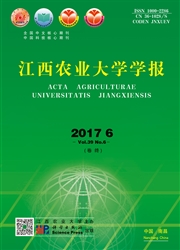

 中文摘要:
中文摘要:
选择性剪接是真核生物产生蛋白多样性的一个重要机制,并能通过产生不同的剪接本来调节基因在不同组织或发育阶段的表达而发挥其作用。本研究采用3条5'LongSAGE标签序列作为上游引物,通过RT-PCR克隆了西方蜜蜂(Apis mellifera)的一个预测基因座LOC727225的4条cDNA序列(GenBank登录号:JN627500至JN627503)。将cDNA序列对蜜蜂基因组作图发现,雄蜂头部中该基因的mRNA前体经由两种不同的剪接方式产生的2个长度不同的剪接本,其中较短的剪接本编码一个功能未知的新蛋白,而较大剪接本的推导产物蛋白与分支酸合酶和神经胰蛋白酶具有序列相似性。5'LongSAGE标签数据显示,LOC727225在成年雄蜂头部的表达水平非常高,RNA PolⅡ可从该基因的6个不同的转录起始位点(TSS)上以不同效率起始转录,其中在2个优势TSS上所起始的pre-mRNA被剪接成较小的剪接本,其数量占该基因成熟mRNA分子总量的90%。启动子序列分析显示,LOC727225是受细胞周期转录因子E2F和StuAP调控的靶基因,该基因可能在蜜蜂的细胞增殖中起重要作用。研究首次证实了基因座LOC727225的选择性剪接和选择性起始,结果为深入探索该基因的功能奠定了基础。
 英文摘要:
英文摘要:
Alternative splicing is an important mechanism to increase diversity of protein in eukaryotic cell,and can modulate how a gene acts in different tissues or developmental stages by generating distinct splicing variant.In this study,four cDNA sequences of a hypothetical gene locus(LOC727225) on genome sequence of Apis mellifera through RT-PCR were cloned by using three different 5′LongSAGE tag sequences as up-stream primers,and the cDNA sequences were submitted to GenBank under the accession numbers JN627500,JN627501,JN627502 and JN627503.According to the mapping result of cDNA sequences on Apis mellifera genome,it was observed that the pre-mRNA of LOC727225 alternatively spliced into two transcript variants.Protein analysis revealed that the smaller splicing variant encoded an unknown protein,while the deduced polypeptide from the larger variant had sequence similarity with chorismate lyase and neurotrypsin.The mapping result of 5' LongSAGE tag sequences on genome sequence showed that LOC727225 was highly expressed in drone head,and RNA PolⅡ initiated transcription of this gene at six alternative TSS with different efficiency.It was observed that the pre-mRNAs from two dominant TSSs were processed into the smaller splicing variant,which accounted for 90% of the total mature mRNA molecules from this gene.Promoter analysis revealed that LOC727225 was a target gene of transcription factor E2F and StuAp,which were regulators of cell proliferation.These results suggested that LOC727225 plays an important role in development or cell cycle.This analysis might be helpful to function study of this honeybee gene.
 同期刊论文项目
同期刊论文项目
 同项目期刊论文
同项目期刊论文
 期刊信息
期刊信息
